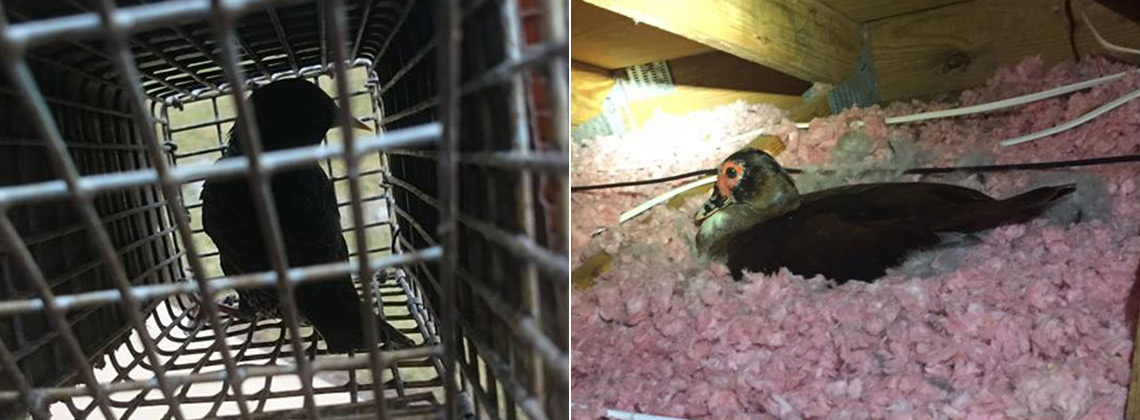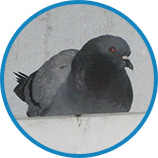Bird Removal - How to Get Rid of Birds
Birds - Problems They Cause, Methods of Removal and Prevention: There are a couple of bird species that are considered pests, and wildlife control gets a fair amount of calls regarding them, especially pigeons. Invasive bird situations often times call for specialty services such as bird removal and damage control pros. Lots of birds can make trouble for homeowners or building administrators, and any type of bird can get trapped inside a building. I'm going to discuss below the most commonly encountered bird problems, and which are the birds that tend to annoy humans the most with their unsolicited behaviors, as well as how to best deal with such cases.

Problems birds cause
Depending on the type of bird in question, there's a variety of problems these feathered reptiles can and will cause if left unattended. The pigeon, popularly known as the rat of the bird world, is arguably the most annoying urban bird, leaving behind incredible amounts of droppings, feathers, parasitic insects and nesting debris wherever they roost, most commonly on buildings, on ledges and beams, on commercial and traffic signs, and quite frequently, in home attics or abandoned buildings. On top of their waste being inaesthetic, it also presents a health risk, especially if left to pile up, and particularly if the pigeons are living and defecating in the attic or the ductwork of your home. People may inhale fungal spores that develop in damp environments where there are large quantities of bird waste, and develop histoplasmosis. Because of the level of causticity pigeon waste has, it can produce corrosion in building structures. People that had the misfortune of a pair or more pairs of pigeons nesting in their attic also complained about the incredible noise they make – even if it's just two of them – stomping like angry rhinos all over the attic floor and making a ruckus with their wing flapping. Many other bird species can be extremely annoying, especially when they nest in hard-to-reach places such as air ducts or balcony ledges – they stink up the place and make lots of noise, especially when the young hatch and start asking for food.
Another bird that is consistent with avian pests is the woodpecker. Woodpeckers may be beautiful birds and fun to watch when in action, but they're not so fun if they start pecking at your house. They may be looking for food or just marking their territory, but you can't get any closer to exterior home damage caused by small nuisance animals than a bird actually drilling holes in a wooden architectural structure. Any kind of bird that flies through an open window or door, and gets stuck in your apartment or house can break objects as it is trying to escape the room, and it can produce staining and bad smells if it needs to defecate or urinate, or if it becomes incontinent due to fear and shock.
Geese and ducks are next on the list, particularly the Canada goose and, if you live in Florida, the Muscovy duck. Canada geese travel in large flocks most of the time, and decide to spawn in very inadequate places, like neat lawns, pretty parks, and golf courses. They often cause damage to sod, and defecate all over leaving behind large droppings that can be toxic. They also become aggressive when feeling threatened. The Muscovy duck is also productive with its droppings, but can be even more problematic than the Canada goose because it can easily contaminate natural water sources with its waste, and cause significant damage to the terrains they frequent. What's more, they are known to be aggressive towards people, and they chase away other bird species that may inhabit the same environment they are, taking over their habitat and their nests. Both the Canada goose and Muscovy duck are extremely destructive, and need to be dealt with as soon as it looks like they're planning on setting shop somewhere, especially if near agricultural land or water.
Methods of removal and prevention
If we're talking about pigeons, the best method of dealing with the situation is through prevention. Dastardly would suggest otherwise, but I do not recommend you nab a pigeon, jab a pigeon, tab a pigeon, or grab a pigeon, although I do encourage you to invent a thingamabob that catches that pigeon (those who don't get the reference will have to excuse my derailing). Back to being serious, capturing and relocating pigeons will prove to be rather inefficient as these birds can come back even if they've been freed more than 15,000 miles from the original location. If the pigeons live in urban settings on buildings, urban bird management tactics should be put in place by making their roosting spots unwelcoming. This means installing pigeon spikes and other such things that make it impossible or uncomfortable for the pigeon to land on that particular spot. If the pigeons occupy the interior of a building they need to be shooed away, and all entry points need to be closed. Same applies if feral pigeons invaded your attic, or if they like to roost on the exterior of your house on beams and ledges. Get the birds out and secure the area for the former, install bird control spikes or another type of roost modification for the latter. Exterior bird droppings should be removed with a pressure washer hose, and interior bird droppings should be removed with the help of a vacuum that has high suction capability, and then the area should be disinfected with a strong odor eliminator product that's safe to use, and that also has the capacity of clearing all the remaining waste and neutralizing all bacteria (I use and recommend a product called Bac-A-Zap).
Woodpeckers are a different matter, as you can imagine. As with all other pests, audio and visual deterrents are heavily commercialized, and you can try them if you want, but they rarely work, or they don't offer a permanent solution. To have a chance with such deterrents, you need to act immediately after you notice the bird, and not wait for it to establish its territory. Woodpeckers should not be killed as they are protected by US federal law under the Migratory Bird Treaty Act of 1918, so you can't use fatal traps. Non-fatal traps are tricky when it comes to woodpeckers, and you will have the same issue as with pigeons when it comes to relocation – the bird will find its way back home. Best control method is to net the building. If netting is applied correctly, this tactic will be successful – and you can take my word for it.
If a bird flew inside your home and can't seem to figure its way back out, you should make sure that only one window or only one door is left open in the room for the bird to get out through, and leave the bird alone. If a couple of hours pass, or if you need to use the room and can't wait for more than a couple of minutes, and the bird hasn't left yet, you can try guiding it towards the exit with a sheet that you would hold up open with your arms spread – make a case of not touching the bird, as they are fragile creatures and it doesn't take much for them to get hurt.
As always, my sincere advice is for you to contact a professional remover who will know how to approach the situation in a safe manner that will be successful in helping you with your bird problem. A small intruder bird in the house or two pigeons that have just moved in the attic may not be such difficult tasks, and you may solve the problem yourself quickly without major difficulties, but the other tons of bird problem scenarios that might occur may prove to not be as straightforward, and will certainly require the help of an expert.

Bird Removal - How to Get Rid of Birds
Why do woodpeckers peck on houses?
How to remove pigeon feces from concrete?
How to get rid of birds in the attic
What is Goose Egg Addling?
How to remove pigeon feces from concrete?
Biology of Pigeon: Appearance, biology, life cycle, habitat, diet, behavior
How to use one-way exclusion funnels to remove pigeons without trapping them
How to get pigeons out of the attic
Will a pigeon in the attic have a nest of babies?
Will repellents get a pigeon out of the attic?
Do mothballs or ammonia help repel pigeons?
Will a high pitch sound deterrent machine work to get rid of pigeons?
How to get pigeons out of a wall
What if a pigeon got inside my house, bedroom, and kitchen?
What equipment is needed to exclude a pigeon?
What is the best material to exclude pigeons?
What is pigeon needle strip?
What is pigeon shock track?
About pigeon bird netting to keep them away
Will a plastic owl scare a pigeon?
Will rice or Alka-Seltzer kill a pigeon?
Is it legal for me to trap a pigeon?
Should you ever trap a pigeon in a cage?
What should I do with a pigeon after I catch it in my house?
Should I relocate a pigeon?
Should I ever poison a pigeon?
Are pigeon feces dangerous to touch or breathe?
How do I clean pigeon feces out of my attic?
What do wildlife rehabilitators do with pigeons?
Do pigeons make good pets?
What to do about pigeons in chimneys?
What diseases do pigeons carry?
What are some of the symptoms of a sick pigeon?
Do more birds live in urban areas or rural areas?
What is a pigeon’s natural diet?
What is a Pigeon’s mating habits?
How to keep pigeon’s out of a barn.
What should I do about pigeons in my chimney?
Should I hire a pro or remove pigeons myself?
Will the city or county animal services help me with a pigeon issue?
Will homeowners’ insurance pay for pigeon damage?
How to find and remove a dead pigeon.
What kinds of damage do pigeons cause in an attic?
What areas can pigeons enter a house through?
What property modifications will keep down pigeon population.
How to inspect a house of pigeon entry points
How do pigeons communicate?
Should I feed Pigeons?
Will a pest control company remove a pigeon?
How to trap a Canada Goose
What kind of damage can Canada Geese cause?
Canada Goose Repellents - Types, and do they work?
How to Get Rid of Canada Geese
About Canada Goose: Appearance, biology, life cycle, habitat, diet, behavior
How to kill Canada Geese
Canada Goose Prevention - How to keep Canada Geese away from yard or pond

